Bok choy is a tasty and healthy vegetable with vitamins and minerals such as vitamin C, K, and calcium. It can be cultivated hydroponically as well as in soil-based gardens. A hydroponic garden is a soil-free method of growing plants that employs a nutrient-rich water solution to supply plants with the nutrients they require for growth. Hydroponic gardening provides advantages such as faster growth rates, bigger yields, and greater control over growing conditions.
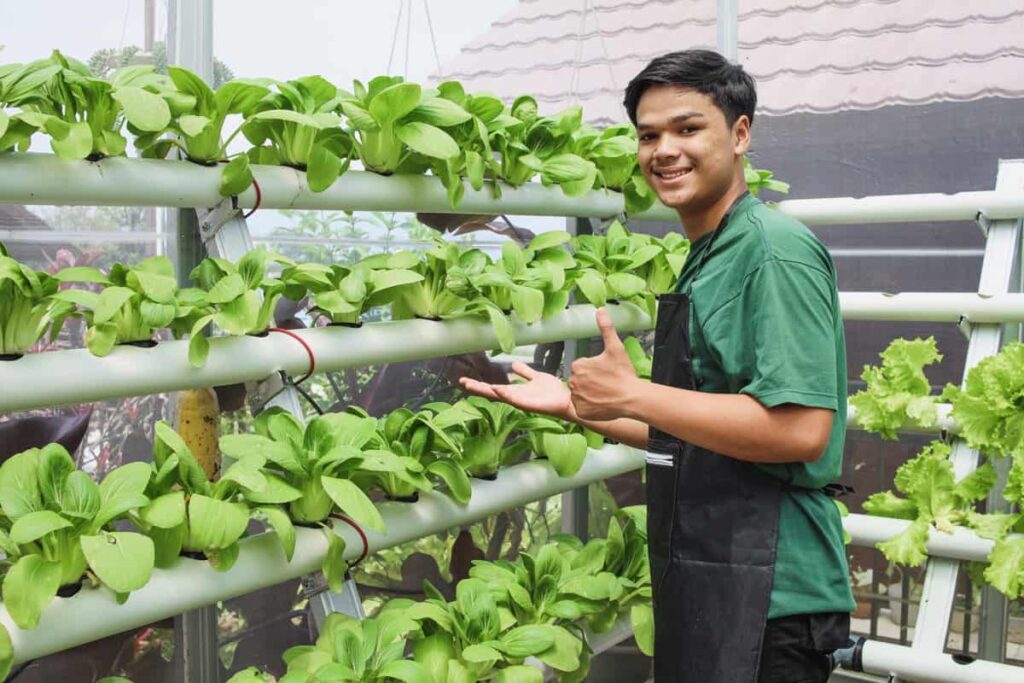
Traditional soil-based gardens can produce up to ten times more crops per unit of space than hydroponic systems. In this step-by-step guide, we will know everything you need to know to grow bok choy hydroponically, from setting up your hydroponic system to harvesting your delicious and nutritious crop.
How to Grow Bok Choy Hydroponically
What is Bok Choy?
Bok choy, or pak choi or pok choi, is a Chinese cabbage commonly used in Asian cuisine. Unlike other cabbage varieties, bok choy does not form a head and has green leaf blades with lighter bulbous bottoms, including a cluster resembling mustard greens. It has a unique flavour between spinach and water chestnuts, with a slightly sweet and mildly peppery undertone.
Bok choy is a popular vegetable in southern China, East Asia, and Southeast Asia and is increasingly grown in Northern Europe due to its winter-hardy nature. It belongs to the family of Brassicaceae or Cruciferae, also known as the mustards, crucifers, or cabbage family.
- Bok choy requires bee pollination to produce viable seeds but doesn’t need pollination to grow and produce an edible harvest.
- Bok choy leaves are the part of the plant that you eat, and they can be eaten raw or cooked.
- Raw bok choy leaves are healthier as cooking can reduce their nutritional value.
- Bok choy is anti-inflammatory because it detoxifies the liver as a cruciferous vegetable.
In case you missed it: Hydroponic Nutrient Chart: For Vegetables, Herbs, and Flowers
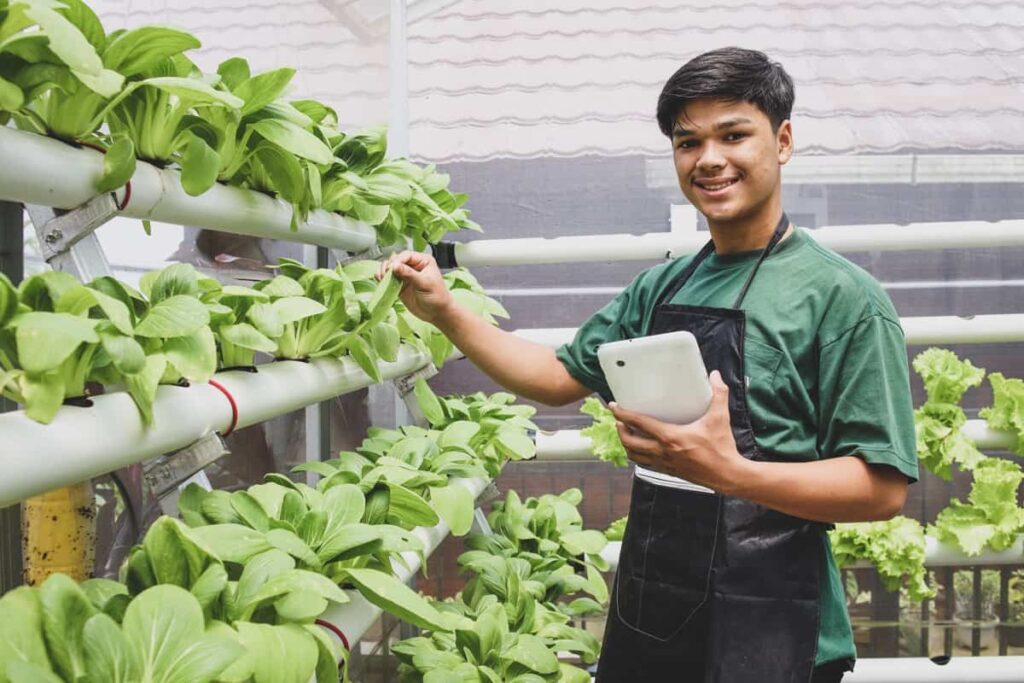
Why Need to Use a Hydroponic System for Growing Bok Choy?
- Hydroponic systems can produce up to 10 times more vegetables per unit of space than traditional soil-based gardens.
- Hydroponic gardening allows greater control over growing conditions, such as pH levels, nutrient concentrations, and water supply.
- Hydroponic systems can be set up indoors, making it possible to grow bok choy year-round regardless of weather conditions.
- Hydroponic systems require less water than traditional soil-based gardens, making them more environmentally friendly and cost-effective in the long run.
- Hydroponic gardening can reduce the risk of plant diseases and pests, as soil absence eliminates many factors that can promote their growth.
Benefits of Growing Bok Choy Hydroponically
- Hydroponically grown bok choy is free from soil-borne diseases and pests, resulting in healthier and more nutritious plants.
- Bok choy is a low-calorie vegetable rich in vitamins and minerals, such as E, C, and beta-carotene, which have antioxidant properties that protect against cellular damage.
- Bok choy is high in selenium, a mineral that aids in detoxification and may lower the risk of certain forms of cancer.
- Because of its high vitamin C concentration, bok choy is also useful to our skin, promoting healthy and smooth skin.
- Hydroponic systems can supply bok choy with appropriate growing conditions, resulting in faster growth rates, larger yields, and more consistent quality.
Facts to Know Before Growing Bok Choy in Hydroponics
- Bok choy can be grown using any hydroponic method, and the best grow medium is either rockwool or coconut coir.
- The germination time is between 4 to 7 days, and the time to maturity varies from 30 to 60 days, depending on the variety and desired size.
- The optimal pH range is 6.0 to 7.0, and any well-balanced nutrient mix for lettuce is suitable for bok choy.
- The recommended EC range (nutrient strength) is 1.5 to 2.5, and growing difficulty is moderately easy.
Setting up a Hydroponic System for Bok Choy
- Choose a hydroponic setup appropriate for your demands and available space, such as deep water culture, nutrient film technology, or drip irrigation.
- Choose a growing medium with water and nutrients, such as Rockwool or coconut coir.
- Set up the hydroponic system according to the manufacturer’s instructions.
- Add water and nutrients to the system according to the recommended ratios for bok choy.
- Adjust the pH of the water to a range between 6.0 and 7.0 for optimal bok choy growth.
- Add a vegetative grow light for 6-7 hours of continuous light daily.
- Plant bok choy seedlings in the growing medium and place them in the hydroponic system.
- Monitor the water, pH, and nutrient levels regularly and adjust as needed.
- Harvest bok choy when it reaches 4-6 inches in height, and replant new seedlings as needed.
In case you missed it: Hydroponic Farming Cost and Profit in India: Cultivation and Production Management
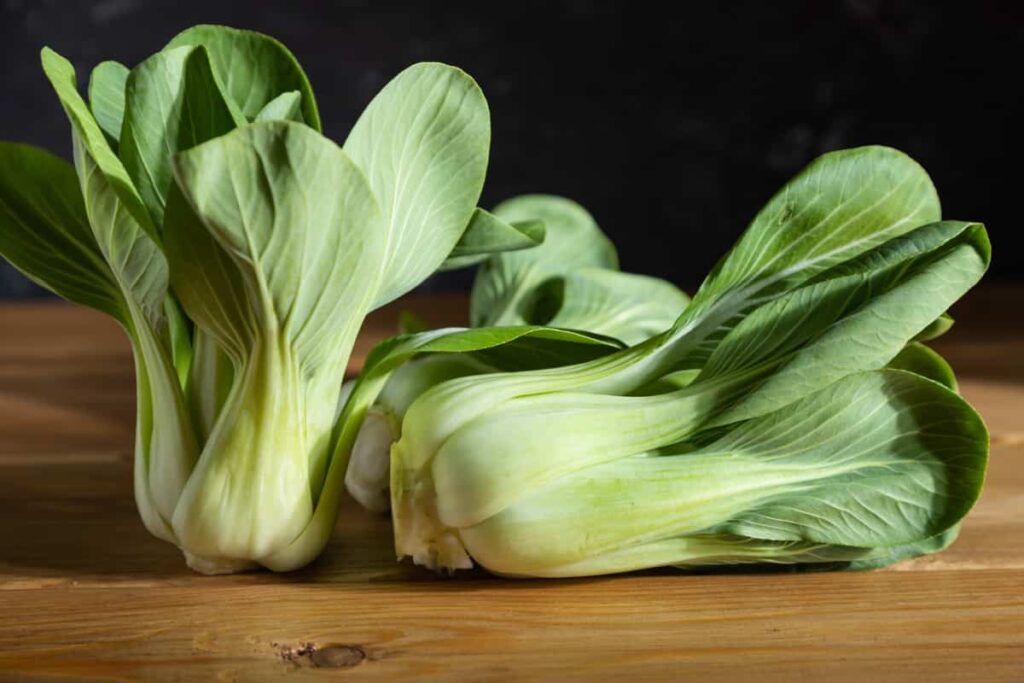
Germinating Bok Choy Seeds for Hydroponic
- Bok choy seeds can be sprouted in a paper towel, sewn directly into rock wool cubes, and kept moist.
- The ideal temperature for sprouting bok choy seeds is 75-85 degrees Fahrenheit.
- Bok choy seeds do not require light to sprout but should be given light immediately after sprouting to prevent legginess and mould/mildew growth.
- Bok choy seeds typically take 4-7 days to germinate.
Optimum Growing Conditions for Bok Choy in Hydroponic
- Bok Choy, a member of the Brassica family, prefers a cooler environment and grows best at temperatures ranging from 13 °C to 24 °C.
- It is necessary to monitor the pH and temperature of the nutrient solution as high temperatures can decrease its oxygen-retaining capacity.
- The electrical conductivity of the nutrient solution should be frequently measured and maintained within an optimum range of 1.5 to 2.5 for Bok Choy.
- High EC levels indicate a high amount of nutrients, and vice versa. Additionally, the pH of the nutrient solution should be maintained between 5.5 to 6.5 for optimal availability of macro and micro-nutrients.
Planting Bok Choy in a Hydroponic System
- Choose a hydroponic system that suits your needs and space, such as an ebb and flow system or a deep water culture system.
- Use a growing medium like rock wool or coconut coir to anchor the bok choy seeds or seedlings.
- Ensure that the pH level of the nutrient solution stays between 6.0 and 7.0 and that the EC range (nutrient strength) is between 1.5 and 2.5.
- Place the bok choy seeds or seedlings in the hydroponic system, and provide adequate light and nutrients to encourage growth.
- Bok choy can be grown in hydroponic systems indoors or outdoors, with a time to maturity that varies depending on the variety and desired size.
Nutrient Requirements for Bok Choy
- Bok Choy requires a nutrient solution of fertilizer salts dissolved in water.
- Fertilizer salts with high solubility should be used in hydroponics for better plant availability.
- Poor-grade salt may contain inert particles that can block the growing channels.
- Bok Choy needs two different nutrient formulations. One is used until the plants are about 3-4 weeks old, and the second is used after this stage.
- Bok Choy can tolerate high levels of nitrogen, which promotes vegetative growth.
- It is recommended to use chelates of manganese, iron, and zinc in the nutrient solution for better availability to the plant.
- The optimal pH range for Bok Choy is between 6.0 to 7.0.
- Bok Choy requires a well-balanced nutrient mix for lettuce with an EC range of 1.5 to 2.5.
- Proper management of nutrients is essential for healthy growth and optimal yield of Bok Choy in hydroponic systems.
In case you missed it: 20 Key Rules for Setting Up a Budget Hydroponic Garden at Home
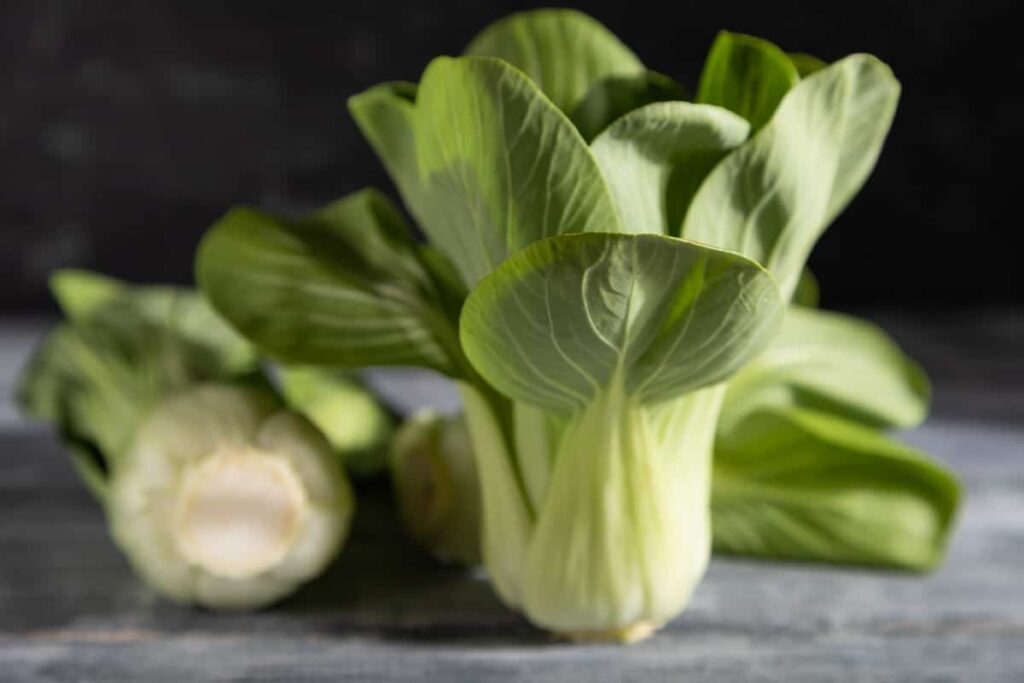
Monitoring and Maintaining a Hydroponic System for Bok Choy
- Monitor the pH range of the nutrient solution regularly and adjust it if necessary to maintain the optimal range of 6.0 to 7.0.
- Check the nutrient solution’s EC (electrical conductivity) level to ensure that it is within the recommended range of 1.5 to 2.5.
- Monitor the temp and humidity levels in the grow room or greenhouse to ensure they are within the appropriate range for bok choy.
- Inspect the plants for signs of pests, diseases, or nutrient deficiencies, and take appropriate action if necessary.
- Clean the equipment and reservoir regularly to prevent the build-up of algae and other contaminants.
- Maintain a regular watering and feeding schedule to ensure the plants receive consistent nutrients and water.
Harvesting and Using Bok Choy
- Baby bok choy can be harvested as soon as 30 days from transplanting, while full-grown heads will take around 60 days to reach maturity.
- Cut the bok choy off at the base with a sharp knife when it’s big enough to eat, and remove the base and roots after cutting.
- Baby bok choy can be cooked whole with as little as four or five leaves.
- Don’t twist or snap the plant off; it has a wide and strong base.
- After 5-6 weeks from transplanting, the bok choy is ready for harvesting, and it can be harvested entirely as the whole upper plant is edible.
- Bok choy is a single-harvest crop, meaning once it’s harvested, nothing will grow back.
- Culinary use: Bok choy can be cooked by steaming, stir-frying, or simmering in water for 2-3 minutes. It can also be eaten raw and used similarly to other leafy vegetables.
- Preservation: Dried bok choy is saltier and sweeter, while pickled bok choy remains edible for months. Immature plants have the sweetest and tenderest stems and leaves.
Tips for Growing Hydroponic Bok Choy
- Space your plants at least 14 inches apart to prevent disease, but you can start with plants as close together as 6 inches and thin them later.
- Keep the pH range between 6.0 and 7.0 to avoid damaging the plants, with the ideal growth pH being 6.5.
- Provide continuously around 6 to 7 hours of light daily with lights designed for vegetative growth.
- Start seedlings with a nutrient solution that’s about half-strength to prevent burning, and keep the EC below one during their first few weeks of growth.
- Slowly increase the EC over time to keep the plants bulking up.
- Bok choy has a time to maturity of 30 to 60 days, a light/dark cycle of 6 hours of light and 18 hours of dark, and can be grown in any hydroponic system and any grow medium.
- General Hydroponics Flora Series nutrient solution is a good choice for growing bok choy.
In case you missed it: How to Maintain the pH Levels of Hydroponic Systems: Increase, Decrease, and Stabilize
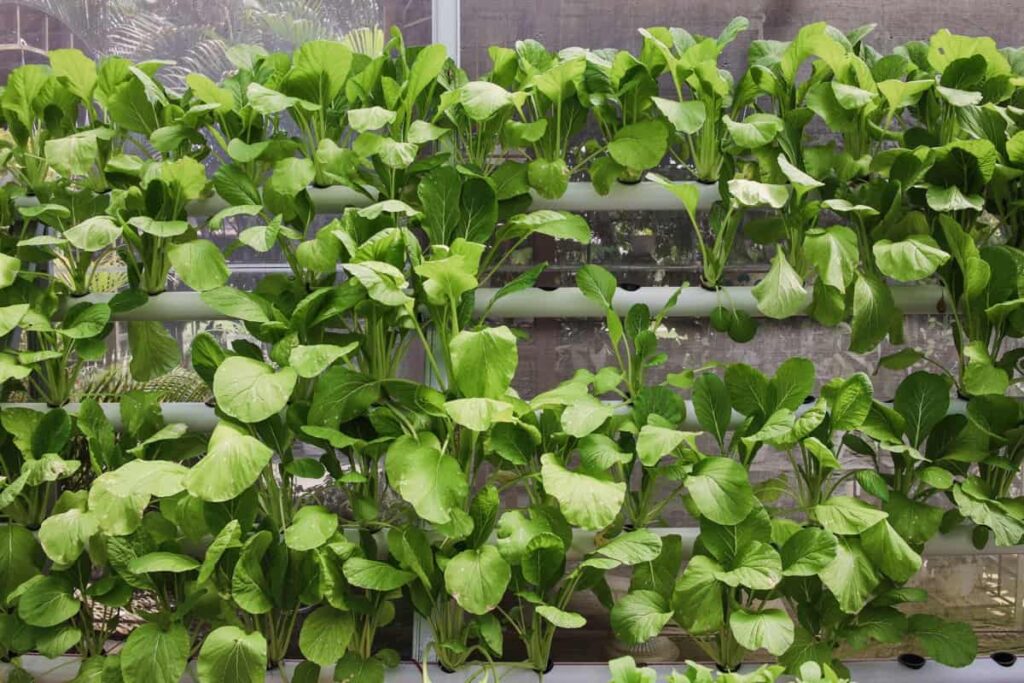
How Long Does Hydroponically Growing Bok Choy Take?
- Bok Choy takes around 28 days to grow hydroponically, reaching a height of 6-8 inches.
- Hydroponic farming can provide higher yields and better quality crops than traditional soil farming.
- Bok Choy is ranked sixth on the Aggregate Nutrient Density Index (ANDI) for fruits and vegetables, making it the best of the most nutritious foods available.
- The ideal pH range for the nutrient solution is between 5.5 and 6.5.
- Fertilizer salts should be used in moderation because they have a longer shelf life.
- Bok Choy leaves are primarily harvested for consumption, and high nitrogen levels encourage vegetative growth.
- Bok Choy can be harvested after only 45 to 60 days of germination and stored for up to four weeks.
- The nutrient solution for Bok Choy should have a PPM of 1050-1400 and an EC range of 1.5-2.
How To Regrow Bok Choy
- Leave about 2-3 inches of the base of the plant intact.
- Place the base of the plant in a shallow bowl or cup of warm water, ensuring that the bottom half of the plant is submerged.
- Place the container on a windowsill and wait for new leaves to appear in the centre of the plant within a day or two.
- After this, transplant the regrown bok choy into a pot or hydroponic system, and in just four weeks, you should have a new crop of nutritious bok choy to enjoy.
How Much Water Is Required for the Growth of Bok Choy?
Bok choy needs consistent moisture to grow properly, and the water required can vary depending on the growing conditions. On average, bok choy requires around 1 inch of water per week or approximately 6-8 gallons per square yard. However, this may vary depending on temperature, humidity, and the soil type or growing medium used.
In case you missed it: How to Start Hydroponic Farming in Australia: Scope, Types, Pros, and Cons
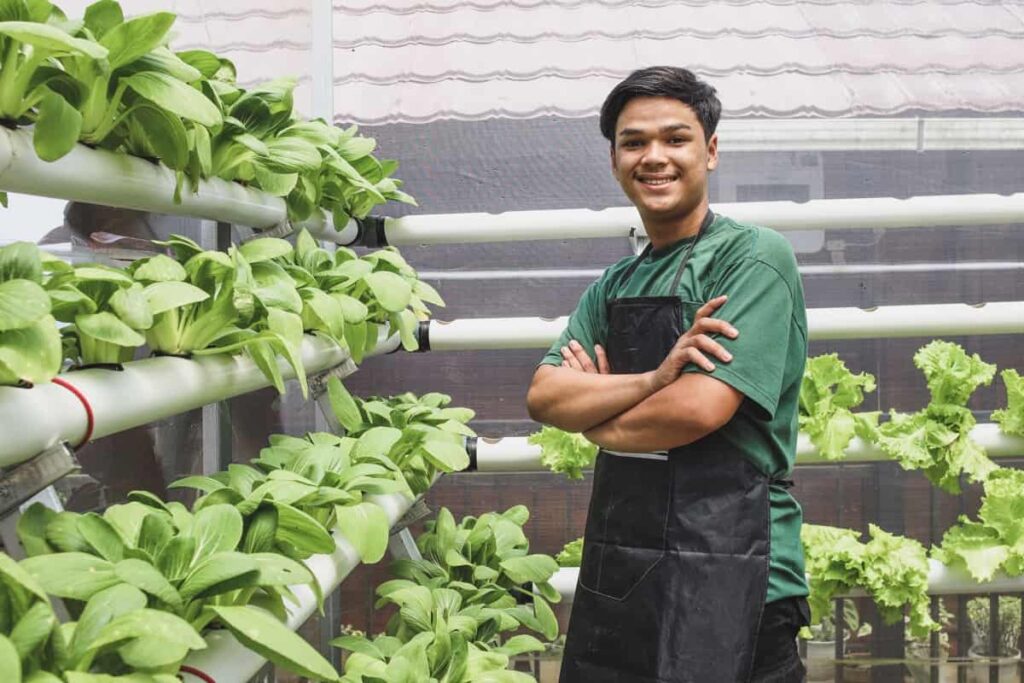
Conclusion
Growing bok choy hydroponically is a great way to produce a healthy and nutritious crop year-round. Following the step-by-step guide for planting to harvesting, growers can enjoy a fast-growing, high-yielding crop that is easy to maintain and harvest. With the right nutrient solution, lighting, and environmental conditions, growers can produce delicious bok choy packed with vitamins and minerals.
- Budget Friendly Sheep Shed Ideas: Cheap and Low-Cost Tips
- How Much Do Cattle Farmers Make: Revenue Streams in Cattle Farming
- Management Pests and Diseases in Your Cotton Field
- Sheep Farming Business Plan for Beginners
- Aquaponic Farming at Home: A Step-By-Step Guide
- Profitable Village Farming Business Ideas in 2024
- High-Yield Aquaculture: Fast-Growing Fish for Farming
- Effective Fish Pond Construction Techniques for Beginners
- Irrigation and Water Management in Pineapple Farming
- Blossom to Harvest: Mastering Flowering and Pollination in Papaya Farming
- Pig Fattening Essentials: From Selection to Sale for Beginners
- Raising Wagyu Cattle: A Complete Guide for Premium Beef Production
- Soil Types and Their Water Holding Capacity
- Optimizing Irrigation Schedules for Coconut Groves for Enhanced Yield
- Espresso Your Garden: Coffee Grounds for Healthier Acid-Loving Plants
- The Best Soil Mix for Snake Plants: How to Mix Your Own Snake Plant Soil
- Green Thumb Success: Expert Tips for Cultivating Greenhouse Beans All Year Round
- Bloom All Year Round: The Ultimate Guide to Indoor Hyacinth Care
- Eco-Friendly Gardening: How to Make Liquid Fertilizer from Kitchen Waste
- Ultimate Guide to Grow Anise in Pots: Explore Seed Propagation to Harvesting
- Guide to Raising Chester White Pigs: Discover Breed Facts to Growth Management
- Mastering the Elegance: The Ultimate Guide to Weeping Cherry Tree Care, Planting, and Maintenance
- Ultimate Guide to Planting Garlic in Grow Bags: Growing Strategies for Beginners
- How to Fix Spider Plant Leaf-Related Problems: Natural and Organic Remedies
- 10 Reasons Why Your Tulsi Plant is Shedding Leaves: Home Remedies and Solutions
- Optimizing Growth and Yield: The Advantages of Palm Bunch Ash Fertilizer
- Utilizing Neem Oil Extract as a Natural Pesticide for Hydrangea
- From Soil to Harvest: Various Ways in Which Farmers Can Use AI Tools
- Steps to Encourage and Induce Citrus Flowers: A Comprehensive Guide
- How to Fix Snake Plant Leaf-Related Issues: Natural and Organic Remedies
- Transform Your Garden into a Fragrant Oasis with Raat Ki Rani (Night Blooming Jasmine)
- Discover the Ideal Chicken Breeds for Philippine Farms
- How to Create a Poultry Egg Farm Business Plan for Profits
- Grow Lemon Cucumbers Like a Pro: Insider Techniques for Bountiful Yields
- Ultimate Guide to Caring for Your Pink Princess Philodendron: Tips for Thriving Variegation
- Areca Nut Profit Per Acre: Calculating Yield and Cost of Cultivation
